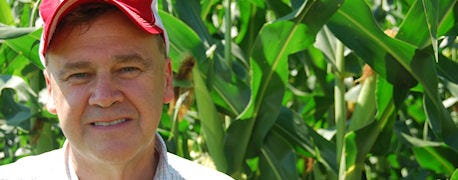February 25, 2013

Corn growers debating between drought-tolerant and conventional hybrids for the 2013 growing season might want to consider how each responds to a variety of growing conditions, an Ohio State University Extension expert says.
While new drought-tolerant corn hybrids are marketed to provide a margin of protection from drought and non-drought stress, growers can benefit from gaining more perspective on the issue - especially considering that in a typical year Ohio crops can endure stress from extreme cold, rain or drought, says Peter Thomison, an OSU Extension agronomist.
Such decisions are crucial as growers hard-hit by the 2012 drought prepare for the upcoming planting season.

Farmers question whether drought-resistant hybrids will produce protection on drought as well as typical growing conditions and whether drought-tolerant hybrids can handle higher plant populations better than traditional hybrids, says Peter Thomison OSU agronomist.
"Growers are aware that weather can have major impact on the practices they pick, and they want to limit their exposure," Thomison says. "Some growers will view the 2012 growing season as an aberration and continue their traditional practices.
"If they're using best management practices, that's fine. But I think that as many growers are hearing more about climate change and the potential for more erratic weather conditions, they don't want to use growing practices that count on good growing conditions and are looking at ways they can weather-proof their crops."
Thomison will talk about the 2012 growing season and new tools growers have for managing drought during a presentation March 6 at the Conservation Tillage and Technology Conference. The conference, which runs March 5-6, is offered by OSU Extension and the Ohio Agricultural Research and Development Center.
The CTC will feature some 60 presenters and include information on nutrient management, soil and water, "Corn University," "Soybean School," crop scouting, no-till and seeding technology.
~~~PAGE_BREAK_HERE~~~Thomison's presentation is a part of Corn University, a series of presentations that Thomison will also moderate, in which agronomists from the University of Illinois, Purdue University and the University of Nebraska will address pressing issues of interest to corn farmers and agriculture industry representatives.
Topics will include seeding rates for maximum yield and planter set-up for maximum yields.
Thomison says an overall goal of Corn University is to help growers gain perspective.
"There are a lot of new products and issues out there, and allows growers to hear presentations from university specialists in an effort to integrate these issues and put them into perspective in terms of their importance," he says. "We want to see long-term data, compare it to existing products and provide more insight and perspective in terms of what is happening in corn planting."
Some of the issues include the question of whether drought-resistant hybrids will produce protection on drought as well as typical growing conditions and whether drought-tolerant hybrids can handle higher plant populations better than traditional hybrids, Thomison says.
The presentations will also focus on other traditional approaches growers can use to manage drought stress, including switching to a corn-soybean rotation for those growers who experienced low yields because of continuous corn production. Other issues include growers choosing to cut their seeding rates to not push growing higher populations because of increased risk.
The Conservation Tillage and Technology Conference is at the McIntosh Center of Ohio Northern University in Ada. The full schedule and registration information is at ctc.osu.edu. Participants can register online or by mail. Registration for the full conference is $85 (or $65 for one day) if received by Feb. 27.
You May Also Like




